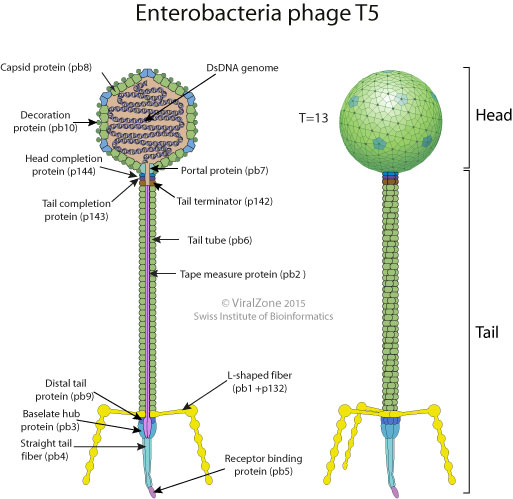Bacteriophage T5 on:
[Wikipedia]
[Google]
[Amazon]
Bacteriophage T5 is a tailed
 The T5
The T5
UniProt: Enterobacteria phage T5
NCBI Taxonomy: Enterobacteria phage T5
{{taxonbar, from=Q24808612, from2=Q18965104 Caudovirales T-phages
virus
A virus is a submicroscopic infectious agent that replicates only inside the living Cell (biology), cells of an organism. Viruses infect all life forms, from animals and plants to microorganisms, including bacteria and archaea. Viruses are ...
within the family '' Demerecviridae''. This bacteriophage
A bacteriophage (), also known informally as a phage (), is a virus that infects and replicates within bacteria. The term is derived . Bacteriophages are composed of proteins that Capsid, encapsulate a DNA or RNA genome, and may have structu ...
specifically infects ''E. coli
''Escherichia coli'' ( )Wells, J. C. (2000) Longman Pronunciation Dictionary. Harlow ngland Pearson Education Ltd. is a gram-negative, facultative anaerobic, rod-shaped, coliform bacterium of the genus ''Escherichia'' that is commonly foun ...
'' bacterial cells and follows a lytic life cycle.
Structure and genome
 The T5
The T5 virion
A virion (plural, ''viria'' or ''virions'') is an inert virus particle capable of invading a Cell (biology), cell. Upon entering the cell, the virion disassembles and the genetic material from the virus takes control of the cell infrastructure, t ...
includes a 90 nanometer icosahedral
In geometry, an icosahedron ( or ) is a polyhedron with 20 faces. The name comes . The plural can be either "icosahedra" () or "icosahedrons".
There are infinitely many non- similar shapes of icosahedra, some of them being more symmetrical tha ...
capsid
A capsid is the protein shell of a virus, enclosing its genetic material. It consists of several oligomeric (repeating) structural subunits made of protein called protomers. The observable 3-dimensional morphological subunits, which may or m ...
(head) and a 160 nanometer-long flexible, non- contractile tail.
The capsid contains the phage's 121,750 base pair, double-stranded DNA
Deoxyribonucleic acid (; DNA) is a polymer composed of two polynucleotide chains that coil around each other to form a double helix. The polymer carries genetic instructions for the development, functioning, growth and reproduction of al ...
genome
A genome is all the genetic information of an organism. It consists of nucleotide sequences of DNA (or RNA in RNA viruses). The nuclear genome includes protein-coding genes and non-coding genes, other functional regions of the genome such as ...
which is predicted to encode about 162 proteins. The genome has a unique sequence of 111,613 bp with two identical large direct terminal repetitions of 10,139 bp. When the genome sequence was published in 2005, only 61 (36.3%) of the 168 encoded proteins had been assigned functions based on homology to known sequences. More than half of all genes (92 or 54.7%) were predicted ORFs lacking similarity to any known proteins.
Infection
Bacteriophage T5 has been shown to infect ''E. coli'' after its receptor binding protein, pb5, binds to the host cell's outer membraneferrichrome
Ferrichrome is a cyclic hexa-peptide that forms a complex with iron atoms. It is a siderophore composed of three glycine and three modified ornithine residues with hydroxamate groups N(OH)C(=O)C- The 6 oxygen atoms from the three hydroxamate g ...
transporter, FhuA. The binding triggers structural changes in pb5 and eventually leads to DNA release from the phage capsid.
References
External links
UniProt: Enterobacteria phage T5
NCBI Taxonomy: Enterobacteria phage T5
{{taxonbar, from=Q24808612, from2=Q18965104 Caudovirales T-phages